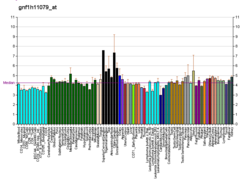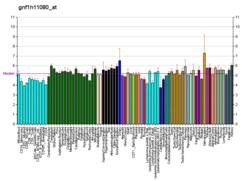| OR5T2 |
|---|
|
| Identifiers |
|---|
| Aliases | OR5T2, OR11-177, olfactory receptor family 5 subfamily T member 2 |
|---|
| External IDs | MGI: 3030920; HomoloGene: 73975; GeneCards: OR5T2; OMA:OR5T2 - orthologs |
|---|
| Gene location (Human) |
|---|
 | | Chr. | Chromosome 11 (human)[1] |
|---|
| | Band | 11q12.1 | Start | 56,231,282 bp[1] |
|---|
| End | 56,234,255 bp[1] |
|---|
|
| Gene location (Mouse) |
|---|
 | | Chr. | Chromosome 2 (mouse)[2] |
|---|
| | Band | 2|2 D | Start | 86,506,562 bp[2] |
|---|
| End | 86,510,436 bp[2] |
|---|
|
| RNA expression pattern |
|---|
| Bgee | | Human | Mouse (ortholog) |
|---|
| | | More reference expression data |
|
|---|
| BioGPS | 

 | | More reference expression data |
|
|---|
|
| Gene ontology |
|---|
| Molecular function | - G protein-coupled receptor activity
- olfactory receptor activity
- signal transducer activity
- neurotransmitter receptor activity
- G protein-coupled serotonin receptor activity
| | Cellular component | - integral component of membrane
- plasma membrane
- membrane
- integral component of plasma membrane
- dendrite
| | Biological process | - sensory perception of smell
- detection of chemical stimulus involved in sensory perception of smell
- signal transduction
- response to stimulus
- G protein-coupled serotonin receptor signaling pathway
- G protein-coupled receptor signaling pathway
- G protein-coupled receptor signaling pathway, coupled to cyclic nucleotide second messenger
- chemical synaptic transmission
| | Sources:Amigo / QuickGO |
|
| Orthologs |
|---|
| Species | Human | Mouse |
|---|
| Entrez | | |
|---|
| Ensembl | |
|---|
ENSG00000181718
ENSG00000262851 |
| |
|---|
| UniProt | | |
|---|
| RefSeq (mRNA) | | |
|---|
| RefSeq (protein) | | |
|---|
| Location (UCSC) | Chr 11: 56.23 – 56.23 Mb | Chr 2: 86.51 – 86.51 Mb |
|---|
| PubMed search | [3] | [4] |
|---|
|
| Wikidata |
| View/Edit Human | View/Edit Mouse |
|




















